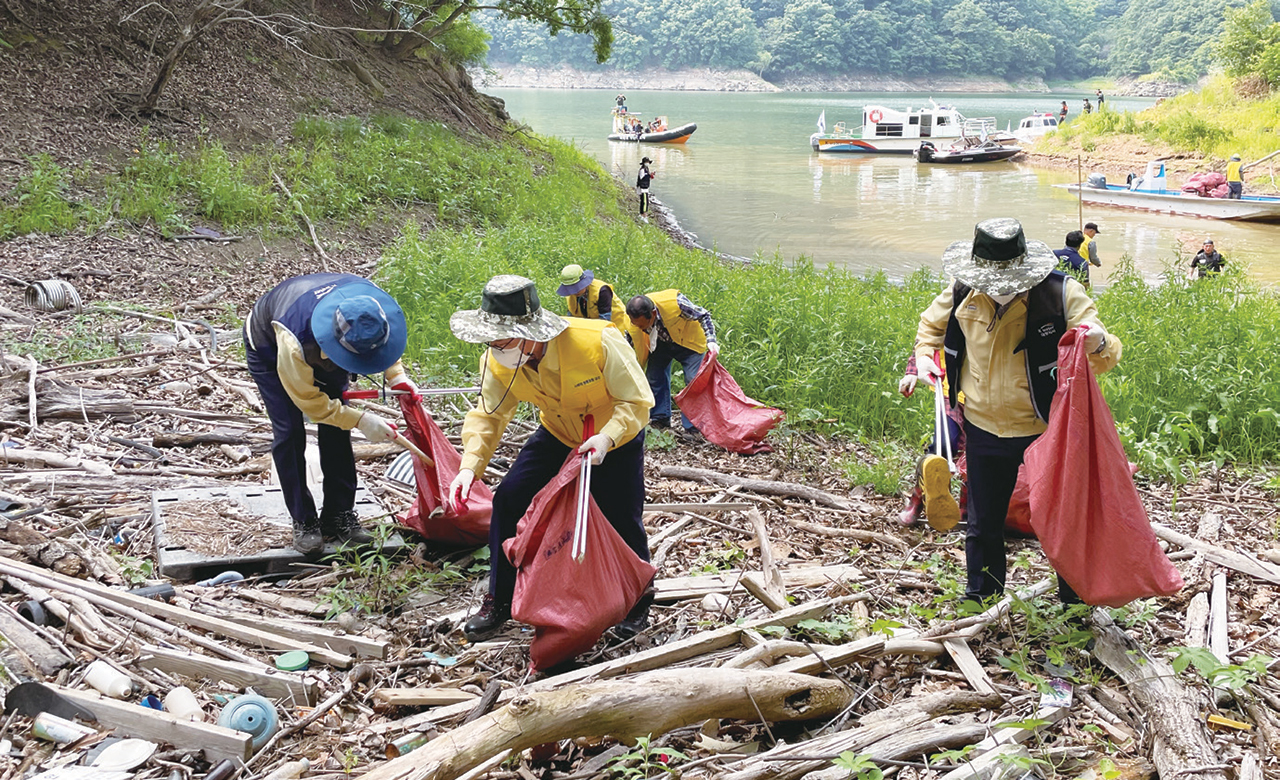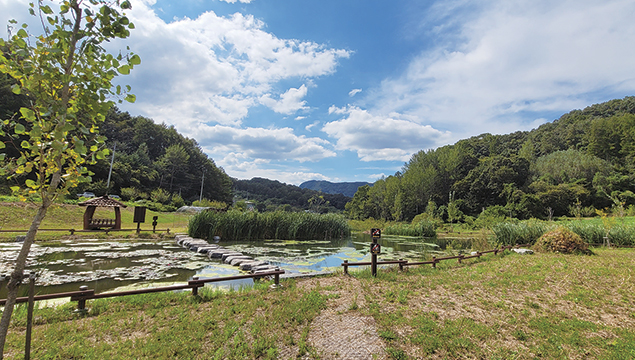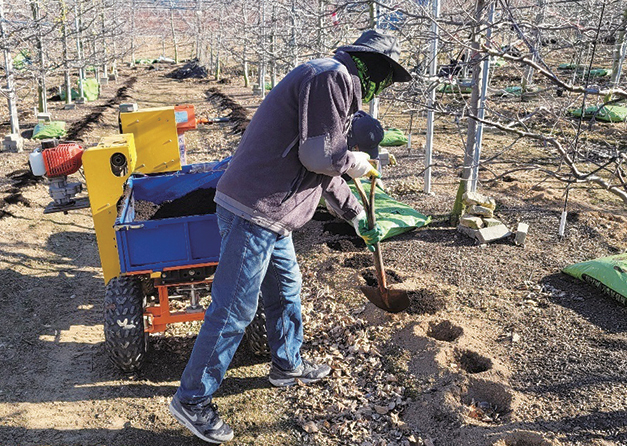-
 2023. February VOL. 659
2023. February VOL. 659

K-water is dedicated to promoting the ecological welfare of citizens by improving water environment including facilitating water cycle through nature-based solutions with a focus on river basins near dams and ensuring the health of the water ecosystem by creating nature-adapted spaces.
It is becoming increasingly important to manage the water environment due to floods, abnormally high temperatures, droughts, and other weather events caused by climate change. River basins of 34 dams cover one-fourth of the total land area of the country. K-water has been carrying out various projects to create a better and more sustainable water environment particularly in the upper regions of dams, many of which are subject to the risk of demographic extinction. The projects include expanding resident-participatory autonomous management programs, creating waterfront eco belts at flood plains, and building ecology and environment villages in an effort to promote coexistence with local communities.
Particularly, floating matters are increasing in basins as a result of torrential rains caused by climate change, and illegal trash dumping, while inflows of pollutants incuding fertilizers and livestock manure pose looming risks of polluting water in water supply sources and damaging the landscape ecosystem. In an effort to cope with this problem, K-water, in partnership with the Ministry of Environment, municipal governments, residents, and NGOs are working on ‘resident-participatory autonomous management projects.’
In May 2021, K-water provided assistance for the operation of ‘Geumgang’, the first social cooperative of 45 residents of Okcheon Country in North Chungcheong Province, which is close to Daecheong Dam. Local residents of areas near 11 dams have formed social cooperatives to work out trash issues including Daecheong Dam(67 members), Yongdam dam(12), Juam Dam(42), Hapcheon Dam(44) and Soyang River Dam(16). The residents are paid wages according to the amount of the trash they collect, contributing to increasing incomes for local residents, while creating 321 jobs and effectively keeping rivers clean. The project produces win-win effects for K-water and local communities. K-water’s ESG-type, resident participation-based basin water management efforts lead to the prevention of water pollution by reducing trash, creating jobs for local residents and promoting growth of local NGOs.
 Picking up trash around the Daecheong Dam
Picking up trash around the Daecheong Dam
K-water has included flood plains close to dams into waterfront eco belts for more effective and integrated management and preservation. A flood plain is an area of land used to store water temporarily when water levels rises due to heavy rains in order to control floods. It has a great impact on increasing biodiversity and ensuring water quality as it also serves as a habitat for various plants and animals. On the other hand, existing waterfront eco belts excluded flood plains, which limit its effects of reducing inflows of pollutants and preserving aquatic ecology. Against this backdrop, K-water decided to launch a pilot project on an integrated waterfront eco belt including a flood plain at the Daecheong Dam.
The pilot project features the creation of the first integrated waterfront eco belt in South Korea by restoring a flood plain into a natural waterfront buffer zone, which gets connected to the land within the existing waterfront area. For monitoring, K-water has created spaces designed to promote resident-led preservation of aquatic ecology and offer hands-on experiences on eco-culture. Surveys and research were launched in 2021 to create eco belts on flood plains at four rivers including the Hangang, Geumgang, Yeongsangang, Seomjingang, and Nakdonggang rivers, with the completion slated for this year. In 2022, K-water has been working on the creation of integrated waterfront eco belts that connect flood plains and waterfront areas in Shinsang District of the Geumgang River Basin and Yiuleo District of the Yeongsangang River Basin. In addition, K-water has striving to enhance water quaity in dams.
K-water has also launched future-oriented projects including development and appication of a new type of a nonpoint pollution reduction facility at the Daecheong Dam and Juam Dam. It is an apparatus-type facility that combines multiple existing pollution reduction facilities to ensure stable operations all year round, and is designed to focus on reducing non-point pollutants during torrential rainfall.
Once the optimal processing technology that fits the characteristics of pollutants released in the upper region of the dam is applied and its effects are proven, K-water will work with local communities to expand the regionally customized water environment management business model to 34 dams under its managment.


The waterfront eco belt created on the flood plain of Daecheong Dam(Jio-ri, Okcheon-gun, North Chungcheong Province)
K-water is working on improving and managing a sustainable basin water environment to fundamentally reduce inflows of pollutants into the upper regions of dams by getting residents actively involved in the process. Gohyeongcheon and three other smaller streams run through Bohyeonsan Dam located in the upper region of the Geumhogang River. When it rains, pollutants enter the streams from the farmland located densely along both sides of the streams. To cope with this problem, K-water started to work with local communities, residents and experts to proactively design and implement a set of comprehensive measures for basin water environment management in 2018. Based on these measures, K-water has been working on 17 tasks in five areas since 2019 for integrated management of water environment including water flow, water quality and aquatic ecology of the Uitmul-Dam-Gohyeoncheon Downstream section.
Buiding upon this, K-water plans to develop a standard model for managing the water environment at river basins, which will be the foundation for reaching and maintaining a Ⅰ in the water quality index, and for achieving mutual growth with local communities.
Resident-participatory villages of crystal clear water were created at the Yeongju Dam, Bohyeonsan Dam and Daecheong Dam, target areas for the stronghold-type pollution reduction project to fulfill social values. By connecting it to the pilot project of the Ministry of Environment to reduce pollution in the basins of the upper regions of water supply sources, K-water changed the surface layer application of fertilizers, a primary cause of nonpoint pollution to deep layer application. K-water has helped boost the local economy by pursuing the following activities: Creating waterfront eco belts, leading the clean village project using photovoltaic panels, launching a farming village experience and tourism promotion project to improve the water environment and create jobs, establishing village cooperatives, getting local residents actively involved in these projects, and sharing profits resulting from all these projects with local communities.
These water projects to reduce soil pollution sources and create a better water environment play an important role in improving the environment in the upper regions of dams and advance eco-tourism in K-water’s pursuit to fulfill the values of ESG management.
 Deep layer application of fertilizer at the Bohyeonsan Dam
Deep layer application of fertilizer at the Bohyeonsan Dam A meeting of the Bohyeonsan Dam Water Environment Management Council
A meeting of the Bohyeonsan Dam Water Environment Management Council